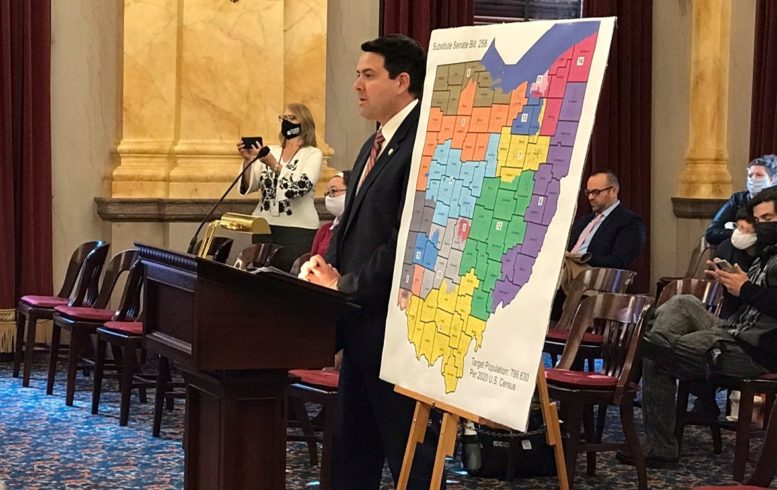BY SUSAN TEBBEN
Ohio Senate Republicans rushed through a congressional redistricting map Tuesday introduced to the public less than 24 hours before.
It was passed out of committee 5-2 along partisan lines before being passed by the whole chamber later in the day 24-7, also along partisan lines.

The passage came on the same day a committee who had been considering a different map as part of Senate Bill 258, substituted the map that state Sen. Rob McColley, sponsor of the bill, said was spearheaded by Senate President Matt Huffman, along with House Speaker Bob Cupp.
An analysis of the map on Dave’s Redistricting App shows seven Republican districts, two Democratic districts and six districts listed as competitive for being within a 54-46 margin. Five in six of the “competitive” districts lean Republican, and the one that leans Democratic, Ohio’s 13th district, does so by 0.88%.
Senate President Matt Huffman said negotiations had been going on since the census data came out, but that in terms of congressional redistricting, Dems and the GOP were “at loggerheads.”
Huffman accused Democrats of gerrymandering, saying their demand was for a map that had six Dem districts and six Republican ones, which he didn’t think was “within the spirit of the reforms.”
“I think we all pretty much knew where we were at,” Huffman said on Tuesday.
Minority Leader Sen. Kenny Yuko, D-Richmond Heights, had previously said on the Senate floor that he had hoped for better.
“I was hoping for a little more compromise. I was hoping there would be a little more conversation,” Yuko said.
State Sen. Cecil Thomas, D-Avondale, said in an argument against the maps on the Senate floor that it was obvious that the 13-2 maps were gerrymandered in favor of the GOP, and even the Democratically leaning Hamilton County was drawn in favor of Republicans in terms of the next election.
“This supposed competitive district leans Republican by more than 3 points…making it an automatic uphill battle for the Democrat,” Thomas said.
The constitution’s “plain language” was the most important part of determining district lines, as McColley argued on the floor of the Senate. Huffman said there were things they had to interpret, such as the shapes of districts, but issues not explicitly stated in the redistricting rules had to take a back seat.
“In the end, the constitution comes first, and those aspirational things come second,” Huffman said.
Thomas and other Democrats criticized the lack of racial data used in determining the maps, just as supporters of Democratic maps had said GOP maps unfairly split communities, particularly communities of color. Huffman doubled down on the fact that Republicans didn’t use racial data, saying it’s illegal for them to do so unless “there is appropriate evidence presented which requires that.”
He said the maps were drawn with race in mind as a divisive factor.
“(Thomas) is wrong that we simply tried to draw lines having to do with race in this case,” Huffman said.
In Senate Local Government and Elections Committee Tuesday morning, McColley defended the map, Huffman and Cupp by saying he supports it as drafted.
“(Cupp and Huffman) have done an awful lot of due diligence and have done an awful lot of discussions on this map, so anything that I’m going to do is going to be deferring to them,” McColley said.
McColley also seemed to suggest that Ohio could be a swing state in saying district lines shouldn’t be the “end all, be all arbiter” for determining political power and the results of future elections.
“You can look in the legislature, you can look in Congress, you can look other places and realize that in many cases, the shifting sands of politics and the issues of the day ultimately are what decide elections, it’s not just simply because you are a 50.1 (percent lean) or a 49.9,” McColley said. “Given a period of time, these seats could switch back and forth potentially over the course of a decade.”
The map was universally panned by anti-gerrymandering groups like All On the Line and the League of Women Voters and Ohioans who have spoke up in committee hearings since the beginning of the process.
Many complaints, as in previous map hearings, rested on procedure, with testimonies that were put in ahead of the 24-hour advance submission rule being tossed out by their authors, because they pointed to a map that was no longer on the table.
Fair Districts Ohio member Trevor Martin said the abbreviated timeline of last night didn’t allow for a comprehensive review of the maps, only an “eyeball test” of the district lines and shapes.
“We have no idea what we’re looking at, what we’re looking at is a mess,” Martin told the Senate committee. “It’s like you don’t hear us, and it’s infuriating.”
Jen Miller, executive director of the League of Women Voters of Ohio, asked in vain for more hearings because without shape files to look at, zooming on a PDF was their only option, and not the ideal way.
Katy Shanahan, of the Ohio chapter of All On the Line responded for several testifiers when state Sen. Jerry Cirino, R-Kirtland, said the anger and accusations of cheating by the Senate GOP expressed by advocates was “a unique method of persuasion on the part of those who are opposing this bill.”
“So, you’re right, a lot of what you’re hearing today is exasperation, it’s frustration and it’s righteous anger that we have to stand here and beg you to care enough about our democracy to do the right thing and deliver on your campaign promises to give us a fair map and a fair redistricting process,” Shanahan said.
***
Also from Ohio Capital Journal:
Commentary: GOP legislative leaders are rigging Ohio elections for the foreseeable future
Nearly 75% of Ohio voters reformed the state constitution in 2018 to end gerrymandering and bring about fair, legal U.S. Congressional districts.
Instead state Republican legislative leaders hijacked the process, betrayed voters, and have all but declared total moral and ethical bankruptcy in their cynical pursuit of political power at all costs.
The behavior of Ohio Senate President Matt Huffman and House Speaker Bob Cupp is despicable, anti-democratic, and un-American.
They are rigging Ohio’s Statehouse and U.S. Congressional elections for the foreseeable future, denying millions of Ohio voters that most essential tenet of representational government: representation itself. READ MORE
Lawmakers pass bill restricting pandemic shutdowns
State lawmakers passed legislation Tuesday that would block the governor from temporarily closing a business due to a pandemic or terrorism event so long as the business follows the safety precautions of still-operating businesses.
The proposal comes in response to lockdowns ordered by governors and health departments around the U.S. in March of 2020 as COVID-19 emerged into pandemic form.
Republican Reps. Jon Cross and Shane Wilkin pitched the bill as a correction to lockdowns that allowed big box retailers like Walmart to remain open as “essential businesses” while smaller retail locations with more niche selections were deemed “non-essential” and were required to close.
The bill allows the health department to shutter a specific business “due to circumstances uniquely present at that particular business.”
Republicans unanimously backed the bill. Senate Democrats all voted in support, though House Democrats split roughly down the middle on the vote. READ MORE





